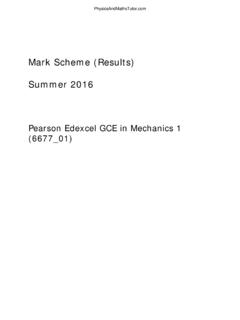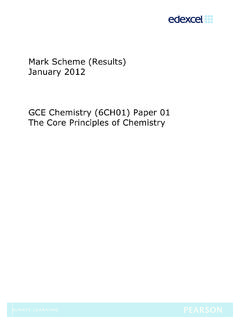Transcription of Mark Scheme (Results) Summer 2015 - Edexcel
1 Mark Scheme ( results ) Summer 2015 Pearson Edexcel international GCSE Chemistry (4CH0) Paper 1C Science Double Award (4SC0) Paper 1C Pearson Edexcel Level 1/Level 2 Certificate Chemistry (KCH0) Paper 1C Science (Double Award) (KSC0) Paper 1C Edexcel and BTEC Qualifications Edexcel and BTEC qualifications are awarded by Pearson, the UK s largest awarding body. We provide a wide range of qualifications including academic, vocational, occupational and specific programmes for employers. For further information visit our qualifications websites at or Alternatively, you can get in touch with us using the details on our contact us page at Pearson: helping people progress, everywhere Pearson aspires to be the world s leading learning company. Our aim is to help everyone progress in their lives through education. We believe in every kind of learning, for all kinds of people, wherever they are in the world.
2 We ve been involved in education for over 150 years, and by working across 70 countries, in 100 languages, we have built an international reputation for our commitment to high standards and raising achievement through innovation in education. Find out more about how we can help you and your students at: Summer 2015 Publications Code UG041123 All the material in this publication is copyright Pearson Education Ltd 2015 General Marking Guidance All candidates must receive the same treatment. Examiners must mark the first candidate in exactly the same way as they mark the last. Mark schemes should be applied positively. Candidates must be rewarded for what they have shown they can do rather than penalised for omissions. Examiners should mark according to the mark Scheme not according to their perception of where the grade boundaries may lie.
3 There is no ceiling on achievement. All marks on the mark Scheme should be used appropriately. All the marks on the mark Scheme are designed to be awarded. Examiners should always award full marks if deserved, if the answer matches the mark Scheme . Examiners should also be prepared to award zero marks if the candidate s response is not worthy of credit according to the mark Scheme . Where some judgement is required, mark schemes will provide the principles by which marks will be awarded and exemplification may be limited. When examiners are in doubt regarding the application of the mark Scheme to a candidate s response, the team leader must be consulted. Crossed out work should be marked UNLESS the candidate has replaced it with an alternative response. Question number Answer Notes marks 1 a i six circles separated from each other Accept minimum of 4 complete circles Ignore size and shape of circles Ignore arrows and other symbols implying movement Ignore a pattern Reject any touching circles Reject circles joined by bonds No penalty for half-circles at edges of square 1 ii B (They move randomly in the liquid state) 1 iii D (melting) 1 b i B (condensing and evaporating) 1 ii D (N2(l))
4 1 Total 5 marks Question number Answer Notes marks 2 a M1 C (Bromine has a darker colour than air) M2 D (Bromine vapour diffuses upwards) 2 b i C 1 ii M1 ammonia (particles/molecules) travels/diffuses faster / further in same time (than hydrogen chloride) M2 (because of) lower Mr Do not penalise ammonia atoms / ammonium (ions) / ammonia solution in place of ammonia If incorrect choice in (i), then no marks in (ii) If no answer in (i), mark on If C appears in (ii), mark can be awarded in (i) Accept smaller/lighter / ammonia less dense Reject ammonia molecules etc less dense Ignore references to kinetic energy Accept reverse argument for hydrogen chloride / hydrochloric acid for both M1 and M2 2 Total 5 marks Question number Answer Notes marks 3 a M1 bright / white / blinding AND flame / light (OWTTE)
5 M2 white solid Accept answers in either order Ignore shines / glows / sparks Accept burns brightly Reject other colours Accept smoke / powder / ash / deposit in place of solid Reject precipitate in place of solid Ignore grey Ignore name of product and equation Ignore references to decrease in amount of magnesium / heat given off 2 b C (a basic oxide formed from a metal) 1 c i blue Ignore shades Ignore purple Reject all other colours 1 Mark (i) and (ii) independently ii hydroxide (ion) / OH / HO Ignore OH 1 Total 5 marks Question number Answer Notes marks 4 a CaCl2(aq) + H2SO4(aq) CaSO4(s) + 2 HCl(aq) All four must be correct to score Do not penalise upper case letters 1 b M1 filter paper in filter funnel Do not penalise inappropriate size M2 everything else correct Not essential that funnel touches flask Reject beaker/tube for M2 Ignore labels Ignore relative sizes 2 c i Ca2+ / calcium (ion) Reject Ca with incorrect or missing charge 1 Mark (i) and (ii) independently ii calcium sulfate/CaSO4 is partially/slightly soluble OR contains unreacted/excess calcium chloride/CaCl2 (solution)
6 Accept unreacted/excess calcium ions 1 Question number Answer Notes marks 4 d i white precipitate Accept solid / ppt / ppte / suspension in place of precipitate Reject other colours Reject other observations eg fizzing Ignore cloudy/milky/grey 1 ii silver chloride Accept correct formula Ignore incorrect formula Award both marks if both answers in either (i) or (ii) 1 iii (hydrochloric/sulfuric) acid / H+ there OR solution acidic Accept because there are no other ions that could form a precipitate Accept no carbonate/hydroxide (ions) 1 Reject methods that refer to filtrate /solution /crystallisation e M1 wash/rinse (with water) M2 leave it (to dry) / leave in a warm place / place in an oven / place in desiccator / heat it / dry with absorbent paper (eg kitchen/filter/blotting) Ignore other named solvents Accept leave on a window ledge Ignore evaporate it / boil it Award 1 mark for both M1 and M2 correct but in wrong order 2 Total 10 marks Question number Answer Notes marks 5 a i C5H12 Accept H12C5 Ignore gap between C5 and H12 Ignore names Ignore CnH2n+2 1 ii CH2Br Accept elements in any order Ignore molecular formula Ignore 2CH2Br Penalise inappropriate use of upper or lower case letters or numbers(eg CH2Br / CH2BR / CH2Br)
7 1 b i R and U Accept in either order 1 ii D (CnH2n) 1 c C (compound R compound Q) 1 Question number Answer Notes marks 5 d M1 M2 (1,2-)dibromoethane Mark M1 and M2 independently Accept Br atoms in any positions so long as on different carbon atoms Ignore any numbers Accept ethylene dibromide 2 e i Ignore balancing in equation Ignore molecular formula 1 ii bromomethane 1 iii UV or ultraviolet (light/radiation) Accept sunlight Ignore all references to heat and temperature Ignore references to pressure 1 iv D (substitution) 1 Question number Answer Notes marks 5 f i M1 setting out division of each % by Ar OR evaluation C H F 12 1 19 OR 3 6 3 M2 simplest whole number ratio (1:2:1 or ratio shown in notes for M1) M3 CH2F Award 0/3 if division by any atomic numbers / wrong way up / multiplication used Do not penalise roundings or minor misreads of % values (eg for fluorine) Do not penalise use of Fl in (i) If molecular masses used for H and/or F, lose M1 but M2 and M3 can be awarded.
8 Using 2 and 38 gives C2H2F using 2 and 19 gives CHF Using 1 and 38 gives C2H4F Working required for these answers M2 subsumes M1 Accept elements in any order Award 3 marks for correct final answer with no working 3 ii C2H4F2 Accept elements in any order Do not accept C2H4Fl2 1 Total 15 marks Question number Answer Notes marks 6 a (A) refinery gases (F) bitumen 2 b M1 (compound/molecule/substance containing) carbon and hydrogen/C and H (atoms/elements) M2 only Reject atom/element/ion/mixture in place of compound/molecule/substance Reject compound/molecule/substance in place of atom/element Ignore references to bonds / long chains Accept other terms with same meaning, eg solely / exclusively / just M2 DEP on mention of carbon and hydrogen/C and H and no other element 2 Question number Answer Notes marks 6 c (fuel oil molecules/it/they) M1 have higher boiling points M2 are darker (in colour) M3 have higher viscosities / are more viscous Accept converse statements about gasoline Ignore reference to melting points Ignore stronger / more intense (colours)
9 If specific colours stated, award M2 if valid comparison, eg gasoline is yellow and fuel oil is brown, fuel oil is browner Accept thicker/stickier/flows less easily, etc in place of more viscous If gasoline, accept thinner/runnier/flows more easily, etc in place of less viscous Must be a comparison, eg not enough to say fuel oil has a high boiling point unless also a statement that gasoline has a low boiling point MAX 2 if no comparison Accept reference to fractions near the top/up the column in place of gasoline Accept reference to fractions near the bottom/down the column in place of fuel oil 3 d i silica / silicon dioxide / SiO2 OR alumina / aluminium oxide / Al2O3 Accept aluminosilicate(s) / zeolites Ignore silica oxide and alumina oxide 1 ii M1 C2H4 M2 C3H6 Accept in either order Award 1 mark for C4H8 and CH2 2 Question number Answer Notes marks 6 e i insufficient/lack of air / oxygen OWTTE Accept oxygen not in excess Reject no oxygen 1 ii carbon monoxide / CO 1 iii decreases capacity of blood (cells) to carry oxygen OR stops blood (cells)
10 From carrying oxygen Accept CO combines with haemoglobin / forms carboxyhaemoglobin Accept CO displaces/replaces oxygen in haemoglobin Ignore CO combines with red blood cells Ignore references to suffocation / lack of oxygen in lungs stopping breathing / gas exchange Ignore just affects haemoglobin Reject destroys haemoglobin Mark all parts independently 1 Question number Answer Notes marks 6 f i M1 sulfur dioxide AND sulfur trioxide in correct order M2 sulfuric acid Accept names with correct oxidation states Ignore dilute / concentrated Ignore hydrogen sulfate / hydrogensulfate 2 ii M1 acid rain Accept makes lakes acidic / lowers pH of lakes 2 M2 specific adverse effect on specific object plants plants/trees/vegetation/crops/named example eg dies/stunted growth/harmed/damaged/poisoned Ignore deforestation Ignore leaching minerals fish fish/aquatic animals/pond life/marine life/named example eg dies/stunted growth/harmed/damaged/poisoned Ignore references to just animals Accept limestone limestone/marble reacts/corrodes/is eaten away NOT just buildings Ignore rusts or physical process such as erosion / weathering / wearing away / dissolving Accept destroys for adv
















